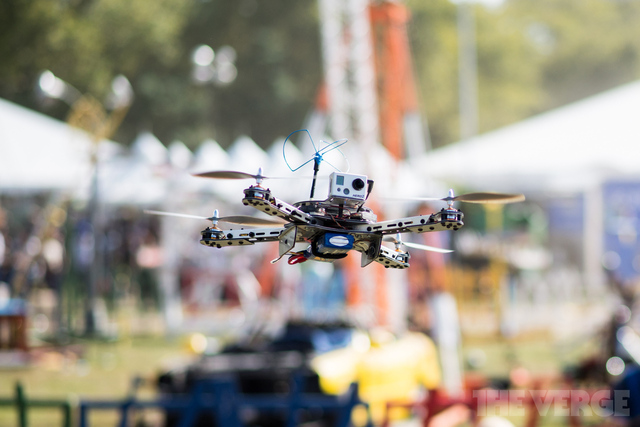
A businessman walking through the East Side of Manhattan Monday was startled when a 3-pound helicopter drone crash landed a few feet from him. The man recovered a memory card from the downed craft and passed it along to a local ABC News station, which broke the story of the accident this afternoon.
The man, concerned that he could have been injured by the falling drone, contacted local police, who told him that no law had been broken and did not pursue the pilot. FAA rules state, however, that hobbyist drones must fly below 400 feet and keep away from airports and heavily populated areas like city streets. The Verge contacted FAA spokesman Les Dorr, but reached the following voicemail message: "I am out of the office due to a lapse in funding. Please call back after news reports advise a resumption of services for all federal agencies."
Chris Anderson, founder of the drone company 3D Robotics and the online community for enthusiasts, DIY Drones, confirmed that this kind of flight was illegal. "The FAA has very clear guidelines on this, and such flying over built-up areas is clearly in violation of those rules (and has been for decades)," said Anderson. "One of the things we created DIY Drones for was to inform people about such regulations and principles of responsible flight. But clearly the message needs to get out better."
The Verge has also reached out to the NYPD for comment.
Comments
Yes SIDs and STARs because they are operating in the airways systems mixing it with the heavy stuff. But of course that's less painful if the clearance is flown at the push of a button. There have been some trials with our size of systems BLOS in the UK, they were flown as we would have done but without eyes on. Once again those pilots were ATPLs but that said if the trials continue and safety is shown then the qualification level will drop. A PPL(U) and CPL(U) actually have place holders in UK CAA documents they just have not worked out how yet.
What, you mean SIDs, STARs, Hemispheric rules and MSAs?
Or is it a VFR departure and DIY terrain clearance until cruising altitude
Or is it just a badly thought out RPAS fudge?
I don't know the answer because I have no IR or (therefore) experience in operating IFR in G - the most likely scenario for many RPAS operators.
You are flying IFR that's why the current European operators being allowed BLOS all hold ATPL's
Controlled airspace is any airspace classified A thru E, although whether you need permission to enter it depends on what class it is and what flight rules you are following - i.e. visual flight rules (VFR), special visual flight rules (SVFR) or instrument flight rules (IFR). SVFR differs from VFR in the visibility limits and is also used to allow VFR-type flight in a normally VFR-excluded airspace that is Class A.
As far as RPAS, it's a bit of a grey area as it doesn't appear at all clear whether one is flying VFR, SVFR or IFR when using an RPAS.
@Andrew
What is the definition of controlled airspace ?
John, a self-imposed rule is no rule at all. If we're talking of rules, we should at least take the time to read them, rather than making the up as we go along.
The 400' and 3 nm from an airport come from not interfering with other aircraft requirement. Civil aircraft are not operated below 500' over non populated areas unless taking off or landing, however they can fly lower due stress of weather. Military aircraft can go as low as 50-100' on some exercises.
The AMA guidelines... Stay below 400 feet within 3 miles of an airport.
Page 2, section 2, subsection (c) HERE.
Free Flight flyers normally max out above 400 feet and often have been OOS (out of sight). Of course our aircraft are RC flyers and the sailplane folk go above 400 feet...but not within 3 miles of an airport.
My eyes are not good enough to determine orientation 400 feet horizontally away from me, much less 400 feet vertically! The aircraft becomes very small, very quickly. In short, if I cannot see it, I cannot control it.
-=Doug
Andrew, the 400ft anywhere rule has been self imposed by the RC community for good reason. And while many of the new generation UAS pilots don't feel they belong in the RC community, a way-point driven UAS has even more reason to follow such a "rule". Imagine how the news will look the day a private/hobby UAS hit's an manned airplane.
@Adrian, please read and parse the clause carefully!
There is no comma after 400ft so that means if you are not within controlled airspace (Class F or G, although only G is used in Australia) or within 3nm of a (licenced) aerodrome then you are free to fly at any height, as long as line-of-sight is maintained without talking to anyone.
Also, you can fly above 400AGL with ATC clearance, if you can get it.
So, you see, the 400ft rule is not a blanket regulation. It would be better if people understood the regulations rather than making them up.
-
1
-
2
-
3
of 3 Next